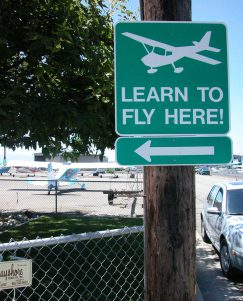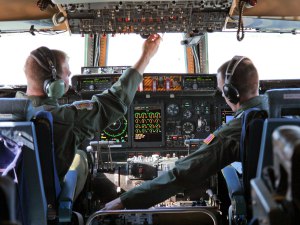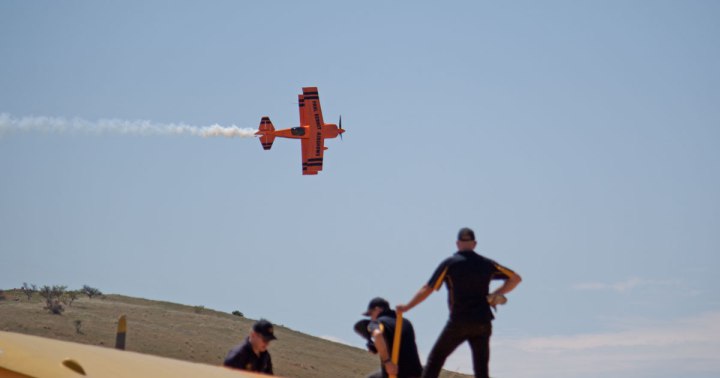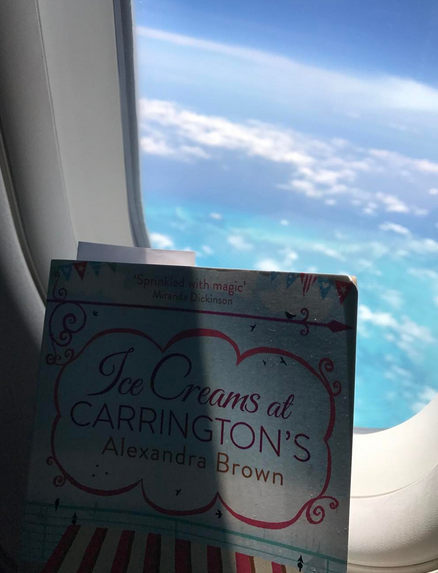 You know you want to… (Nadya Peek | flickr.com CC BY 2.0)
You know you want to… (Nadya Peek | flickr.com CC BY 2.0)
A few weeks back (okay, several weeks now) I received the best kind of email – a query about flight schools from a reader contemplating starting in for her pilot’s licence.
I love the idea of people wanting to become pilots. The magic, the self-discipline, the sensation and the satisfaction are all hard to beat. It’s no stretch to say flying completely changes your view of the world.
There’s way more to it than that, of course. Flying is totally about spreading your wings.
‘You haven’t seen a tree until you’ve seen it’s shadow from the sky’
— Amelia Earhart
In fact the most profound thing becoming a pilot gives you isn’t the ability to fly at all. It’s confidence. And in our increasingly connected and critical society, confidence is the ultimate attribute.
PIREPS welcomeThe email I received was basically asking what to expect from a flight school. But having been down that road already, I think the real question is how to make the most of the flight training experience, no matter where you do it.
After all, it takes lofty dreams and a lot of money to learn to fly. You’d want to finish up with at least one of those still intact.
I can’t hope to answer such a broad subject neatly and single-handedly – then again, I doubt any one person could. So this article is meant to kick-start a conversation rather than save one… If you have your own insights to add, beyond the usual content of flying school brochures and ‘Becoming a pilot’ puff pieces, I hope you’ll do so via the Comments below.
Before we begin How it begins for everyone… Geoff Stearns snapped this shot of a Cessna before climbing aboard for a TIF in 2008. (Geoff Stearns | flickr.com CC BY 2.0)
How it begins for everyone… Geoff Stearns snapped this shot of a Cessna before climbing aboard for a TIF in 2008. (Geoff Stearns | flickr.com CC BY 2.0)
Let’s get the ball rolling with my shortcomings: I’m in Australia for one thing, while my correspondent was in the U.S. Not a bad thing (either way!), just different.
I also learned to fly at a large and very ATPL-oriented school, which probably wasn’t the best choice for me – and might not be for a lot of people. I got lucky. In a setting that just saw the PPL as a necessary step toward more hireable ratings, I managed to maintain my private flying focus within their system, and clear the cobwebs off my high school maths and science memories rather than study in a class-full of epaulettes.
Mind you, I then went on to aerobatics and taildragger training at a small school on a non-towered airport, so I have been to both extremes.
With hindsight, I don’t think I’d recommend a big airline-focused school to anyone now. Even future airline pilots. That style of expedited learning doesn’t do anyone any favours…
It does make a nice segue to the one thing thing every wannabe-pilot should know before they begin though – and that’s where they want to finish.
 The front office of a Gulfstream G.V. It could be the seat of several careers from bizjet or research pilot (this one is used for upper atmosphere studies) to A&P, instrument technician and more. (US National Science Foundation)
Know where you’re going…
The front office of a Gulfstream G.V. It could be the seat of several careers from bizjet or research pilot (this one is used for upper atmosphere studies) to A&P, instrument technician and more. (US National Science Foundation)
Know where you’re going…
If your dream is fly for the airlines, they might still look favourably on that mainstream pipeline (depending how you choose to build up hours after). But that’s far from the only cockpit career option to be shooting for. Bush flying, military or paramilitary, aerial ambulance, stock mustering, top dressing, fire bombing, air shows, charter, corporate jet, freight hauling and ferry flying are just some of the doors that a pilot’s licence can open up.
Even being an instructor – you know, a proper, professional career CFI – can be your end-game. There are lots of less satisfying jobs.
‘When you fly high people will throw stones at you. Don’t look down. Just fly higher so the stones won’t reach you.’
— Chetan Bhagat
 Yes, it IS as amazing as it looks! Sailplane flying is just one way to add skill and enjoyment to your flying. (© Marian Bazala | Dreamstime.com)
Yes, it IS as amazing as it looks! Sailplane flying is just one way to add skill and enjoyment to your flying. (© Marian Bazala | Dreamstime.com)
And while career choices are important, it’s possible (even advisable) to be more than one kind of pilot. Plenty of airline captains ditch the gold braid to fly their homebuilt, sailplane, warbird or family Cessna on their weekends.
There’s a whole other rabbit hole to go down here (starting with airliners saved by their sailplane-flying pilots) but suffice to say that aviating is one of those rare professions where too much is seldom enough.
There aren’t many careers where what you do for money is what you choose to do for recreation as well.
But first, know where you belongFor all that, your dream job is only one part of a much bigger outlook – and possibly even the wrong end of that telescope. Personality type is a much more important career factor.
Fellow aviation blogger Ron Rapp covers this subject really well in his post Know Thyself, and gives a more in-depth example from his personal experience in The Contract Pilot.
Both are well worth a read. You want to be doing work you love in planes you like, rather than being in planes you love doing the work you do.
 The best job in the world? Well, the early starts are beautiful. Dawn departures at YPAD Adelaide, South Australia. (© airscape photo)
The best job in the world? Well, the early starts are beautiful. Dawn departures at YPAD Adelaide, South Australia. (© airscape photo)
Airline flying is a great example, if only because it’s the most obvious career option for aspiring professional pilots. But put down your copy of Fate Is The Hunter for a minute, and appreciate that these days it’s all about cockpit resource and systems management. Great if you’re a people-friendly team player who loves the majesty of big, beautiful sky-liners…. But if you’re a more venturous spirit or enjoy some yank and bank, you should probably kick some other tires. Otherwise, plying the airways at 1.1G could get old before you do.
Not that an airline career isn’t worth shooting for. On the contrary. It’s still the best job in the world – if it’s the best job for you.
Hopefully the rush of other options I mentioned will make it easier to be honest with yourself. It costs nothing to shortlist some career choices then ask the internet about their pros and cons.
 …On the other hand, there’s more than one way to use an airliner rating… Fire fighting from a DC-10 is about as far from line flying as you could get! (US Forest Service | Mike McMillan)
The best use of your talents
…On the other hand, there’s more than one way to use an airliner rating… Fire fighting from a DC-10 is about as far from line flying as you could get! (US Forest Service | Mike McMillan)
The best use of your talents
Now try to take this in your stride – but maybe being a professional pilot isn’t right for you at all.
It’s well worth considering the industry’s plethora of associated careers that will let you get elbows deep in aviation on workdays and pay enough for you to enjoy flying at the weekend.
 I could include any warbird here (and want to fly it!) but a trainer seems most appropriate. This is AT-6 serial N77TX (originally 41-16320)) during Air Expo 2008 at Flying Cloud Airport, Eden Prairie, MN. (Pete Markham | flickr.com CC BY 2.0)
I could include any warbird here (and want to fly it!) but a trainer seems most appropriate. This is AT-6 serial N77TX (originally 41-16320)) during Air Expo 2008 at Flying Cloud Airport, Eden Prairie, MN. (Pete Markham | flickr.com CC BY 2.0)
A career in ATC, airline dispatch, cabin crew, maintenance, manufacturing, management, or aviation media could be a the best (and comprehensive) use of your many talents.
You’ll still get to spend all your time around aircraft, but you can fly on your own terms. Plus, combining systems knowledge with stick skills will benefit you in both spheres.
If your real passion is antiques or warbirds, for example, getting qualified to restore and repair them yourself could prove every bit as valuable as being able to fly the finished article.
Start with the EAA Careers Page for a really comprehensive, categorised list of choices. You may be surprised, you should be better informed, and you will have a considerably wider horizon.
‘I have found adventure in flying, in world travel, in business, and even close at hand… Adventure is a state of mind and spirit.’
— Jackie Cochrane
Go, fly
 The cockpit of this A330 is far from the only aviation job in this photo. There is the dispatcher, cabin crew, and an army of ground staff – any of whom could be practicing pilots. (© airscape photo)
The cockpit of this A330 is far from the only aviation job in this photo. There is the dispatcher, cabin crew, and an army of ground staff – any of whom could be practicing pilots. (© airscape photo)
So here’s the plan: Gaze at your own navel until you know what kind of pilot you’ll be; gaze at the internet until you know which aviation career will suit you; then go to the airport and enrol in the flight school that’s all set up to train [insert end-goal here] pilots.
Easy, right?
Of course not. Have I put the cart before the horse? Absolutely. Do you want to do all that planning stuff first or do you just want to go and start flying? I’ll let you answer that one…
So how do you choose a school that’ll give you the best possible foundation for whatever form your ambitions finally take?
Conveniently, I have a solution.
Get soaked in good airmanship A little wheel goes a long way…. Bellanca 7ECA Citabria CS-AJC (cn 661) taking off in Portugal, 2013. (© Arbaes | Dreamstime.com )
A little wheel goes a long way…. Bellanca 7ECA Citabria CS-AJC (cn 661) taking off in Portugal, 2013. (© Arbaes | Dreamstime.com )
As a matter of fact, I have a handy two-word test that should let you know if any flight school is worth your time and money: Tailwheel. Training.
Okay, this is a clear case of wishing I knew then what I know now. And I’m not saying you ever have to get tailwheel qualified – even though I’d heartily recommend it. But a school which understands the value of taildragger skills enough to hire a suitably qualified instructor and organise an appropriate aircraft must also have an attitude to flying that could be the difference between you getting certified as a pilot or qualified as an aviator.
That’s a semantic division, to be sure. Mostly, the difference will be in your own head but, as you’ll soon learn, flying is all about your attitude.
‘There’s a big difference between a pilot and an aviator. One is a technician; the other is an artist in love with flight.’
— Elrey Jeppesen
The concept of ‘aviator’ occupies a similar space to that of ‘airmanship’. You can fly safely without ever understanding it, and you can understand it without ever being able to explain it, but once either (or both) concepts crystallise in your mind, your flying will transcend your training.
 There are no images of airmanship (what an interesting photo competition that would make!) but let’s just say it’s the difference between people you’d want to share the sky with, and those you don’t. And for interest, this is a crew preflight aboard a C-5 Galaxy. (Robert Couse-Baker | flickr.com CC BY 2.0)
There are no images of airmanship (what an interesting photo competition that would make!) but let’s just say it’s the difference between people you’d want to share the sky with, and those you don’t. And for interest, this is a crew preflight aboard a C-5 Galaxy. (Robert Couse-Baker | flickr.com CC BY 2.0)
Anyway, the mental approach to handling taildraggers is as valuable as the physical skillset. Flying is always unforgiving of mistakes, but taildraggers are just that little bit more so. Especially on the ground. When you take command of a taildragger the flight isn’t over until you’ve tied the plane down afterwards, and you have to pay attention the whole time.
That’s a good habit to get into. And it’s good to have someone in that headspace guiding the first steps of your journey.
Get soaked in good airmanship early, and you’ll be better able to handle any aircraft and aviation career you settle on down the road.
For now, though, there’s all the fun of interviewing schools.
Find the right instructor Physical proximity is just one reason for wanting to like your instructor… (Lars Plougmann | flickr.com CC BY-SA 2.0)
Physical proximity is just one reason for wanting to like your instructor… (Lars Plougmann | flickr.com CC BY-SA 2.0)
As an adjunct to your flying personality it’s important to know – or figure out – who you want to be sitting next to for all those hours of training. Sometimes flying gets stressful. Your instructor might even need to yell at you once or twice, so choosing someone you like and respect is important.
No school’s going to assign you an instructor before you’ve even signed up, but there’s no harm in asking to chat with whoever that might be.
Most people are most comfortable with their peers and I think women, in particular, are more comfortable sharing their high, low and frankly ugly moments with another woman. Nothing wrong with that.
Just make finding the right instructor part of ‘planning to start’, not part of ‘trying to finish’.
Brief. Debrief. Repeat. Alongside all the legendary deeds, most accounts say pilots like Chuck Yeager fly with absolute accuracy, all the time. I aspired to that. (USAF photo)
Alongside all the legendary deeds, most accounts say pilots like Chuck Yeager fly with absolute accuracy, all the time. I aspired to that. (USAF photo)
Even as a purely recreational pilot (an ‘amateur’ in the truest sense of the word) my attitude to flying always seemed to suit crusty, no-nonsense instructors – usually ex-knucks (i.e. knuckleheads, or military aviators). I’m sure they found me lax and incompetent, but I looked up to them and aspired to fly their way. So as a student / instructor relationship it totally worked for me.
One thing ex-military pilots do really well is brief and debrief. It’s deeply ingrained in the nature of their previous job, and for good reason. Apart from the safety benefits of a little forethought, it’s also a lot easier to achieve a goal if you know what that goal is.
So whether your instructor wears khaki pants or not, ask what they provide besides flying time. A thorough pre-flight brief gets the mission plan and objectives straight in everyone’s head. As a student it lets you know what to expect during the lesson and what you should be looking to get out of it.
The debrief is every bit as valuable for consolidating what you just learned, letting you know what to work on, and priming you for the next lesson to come. It’s more of a two-way conversation too: You’re just as entitled to ask the instructor why they did something as they are to question you. Doing so will get you a better relationship as well as a better education.
Besides, it’s just good service. It beats me why a flight school would show you straight from the airplane to the EFT-POS machine to the front door. Along with all the flying benefits, a debrief gets you planning to come back before you leave.
Fine in theory Expect Meteorology, Navigation, Aerodynamics, Flight Planning, Performance and Loading, Human Factors, Air Law… all on top of how to fly the thing. (Australian Bureau of Meteorology)
Expect Meteorology, Navigation, Aerodynamics, Flight Planning, Performance and Loading, Human Factors, Air Law… all on top of how to fly the thing. (Australian Bureau of Meteorology)
Apart from each flight’s brief, instruction and debrief, there’s a lot of aviation theory to master as well. A lot.
On the assumption you’ve been in the education system before, you should know what kind of student you are. Some people like lectures and tutorials; others prefer a book, a legal pad, and a big box of pencils and lots of quiet.
Personally, I think the real divide is whether you’re a procrastinator or a doer. Figure that out and you’ll know exactly what kind of learning environment you need…
Anyway, ‘know thyself’ and be upfront with your flight school about who that is. Not many schools will just cast you loose with a stack of books unless you want them to. Most will offer theory courses either in parallel with your flight training or as topic-specific ‘intensives’ over a few days.
‘If you were born without wings, do nothing to prevent them from growing.’
— Coco Chanel
If you like (or need?) classroom learning, figure out how to make the most of your school’s schedule. If it’s a real problem, heck, you can do your practical training at one school and your theory at another. No reason why you can’t. (Just be ready for the theory school to always be after your flying business too.)
Every flight is a lesson Carrier crews video, review and rate every carrier landing – because even they never stop learning. (USN)
Carrier crews video, review and rate every carrier landing – because even they never stop learning. (USN)
As I said, my preferred instructor was a result of my attitude to flying, to my self-image as a pilot even, and knowing that about yourself might help you choose your instructor as well as your career.
Of course no-one gets the same instructor the whole time. Flying with someone new and potentially more senior can be intimidating – but it’s important to step up and embrace it. Even if you don’t find them as user-friendly as your regular CFI, every instructor will have something new and valuable to teach you.
Even the government’s examiner will be more than happy to teach you a thing or two during your check-ride – assuming you’re across the required knowledge – because you’re never done learning, just because you’re done ‘learning’.
Preflight the flight schoolAs for the nitty-gritty of school selection, it’s a truism that an experienced pilot’s preflight is a catalogue of everything which has gone wrong on them in the past. That time the brakes failed on landing… Now they always inspect the brakes. They day they lost an aileron/door/antenna in flight…? Now every hinge and attachment gets tugged on and double-checked.
 Hangar door at Lilydale Airport, Yarra Valley, Victoria, Australia. (Michael Zimmer | flickr.com CC BY 2.0)
Hangar door at Lilydale Airport, Yarra Valley, Victoria, Australia. (Michael Zimmer | flickr.com CC BY 2.0)
You get the idea. And any advice on choosing flight schools is a bit like that too – a catalogue of annoying gotchas that have all chastened someone, somewhere, sometime. For example, don’t choose a school that’s difficult to get to. Define ‘difficult’ though. Unless you live on the field, expect to commute for at least an hour. (See it as time you can use to get focused.) But ‘difficult’ might be a long, lonely train ride with unsavoury strangers. That kind of thing will stop you going.
Next, look for a clean, well-maintained and reliable aircraft fleet. You don’t need to be an A&P for this, just trust your common sense. (Hint: Clean, well-maintained offices and staff are a good indication.)
‘Luck is the sum total of your of abilities as an aviator. If you think your luck is running low, you’d better get busy and make some more. Work harder, pay more attention. Do better preflights.’
— Stephen Coonts
And while price isn’t actually much of a guide to a good or bad school, most everyone advises against paying for a block of lessons in advance. You just don’t want to be tied to a business which needs your money that badly.
Online reviews, social media posts and blogs from people who’ve been there will also help build up a picture of the place(s) on your list. But at some point you’re going to have to jump on in.
 Photo by Jonathan Oakley | flickr.com CC BY 2.0
Photo by Jonathan Oakley | flickr.com CC BY 2.0
So another good thing about not buying the whole course up-front is you’ll be free to leave if you decide you made a mistake. There’s nothing wrong with that either. Your logbook, your flight hours and your accumulated knowledge will all travel surprisingly well.
Just remember no school can spoon-feed you flying. If you don’t put the work in, it won’t ever work out.
But if you’ve been struggling you might find a change will suddenly unlock your progress. It’s not an indictment on you or your old school. Often it’s just chemistry.
And finally (in case it’s not just chemistry, you need to remember that you’re the customer. A very valuable customer. So if a school or instructor starts treating you like a meal ticket or, worse, a fuel card, take your business elsewhere. Those folks have no place in the dream actualisation industry.
My best tip of allOther hints, tips and tests for a prospective flight school are everywhere. You’ll find them online and in magazines easily enough. Many will recommend a trial instructional flight or TFI, but I’ve I’ve been in enough new business pitches to know the gulf that can exist between presentation and reality.
If you go for a trial flight and get air sick, so what? Chuck Yeager did too. And a shiny new Diamond DA20 Katana can still puke hot oil back over its windshield as well as any battered old C152.
 Aviation people – the other ‘magic of flight’. Oh yeah, and a C-46 Commando, taken at EAA Airventure 2012 by Ken Mist. (visit kenmist.com | flickr.com CC BY 2.0)
Aviation people – the other ‘magic of flight’. Oh yeah, and a C-46 Commando, taken at EAA Airventure 2012 by Ken Mist. (visit kenmist.com | flickr.com CC BY 2.0)
Personally, I think you should save your money for proper lessons or pilot paraphernalia. A far better investment of your time – for no cost, in fact you might even get a free meal out of it – is to ask if you can come along to the school’s next Friday (or whatever) barbecue. Make sure someone’s there to introduce you to the instructors and some fellow students, and spend the afternoon getting to know them and the school that way.
I guarantee you’ll get a better read than a half-hour hop could ever give.
You see, airplanes are awesome and you’ll love nearly all of them. But their best feature is the world of wonderful, welcoming, passionate and generous people they attract. So while most advice seems to focus on the machines, getting to know the people is actually the best way to enjoy flying.
 Wherever you hope to end up, getting started is the most important part. (© airscape Photo)
So, ready to get started?
Wherever you hope to end up, getting started is the most important part. (© airscape Photo)
So, ready to get started?
Cool. Everything you’ve heard is true…
Your first solo really will stay with you for the rest of your life – along with the special charm of the user-friendly spam cans you train in, and the mantras of your favourite instructor. (‘Watch your airspeed. Watch your airspeed. Watch your airspeed.’ – I still drive within a needle-width of the speed limit!)
More importantly, you’ll have the achievement – the accomplishment – of thoroughly learning about yourself, your aircraft and how to operate both of them in harmony.
Plus you’ll gain the confidence of knowing you can cause a flying machine to rise into the air and return safely to the ground…
The confidence to spread your wings.
‘He who would learn to fly one day must first learn to stand and walk and run and climb and dance; one cannot fly into flying.’
— Friedrich Nietzsche
Share this:





